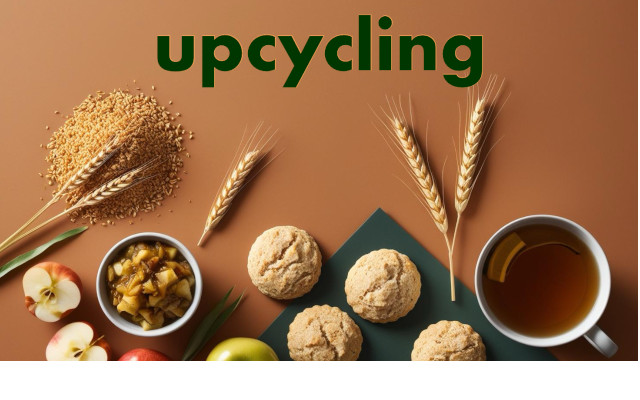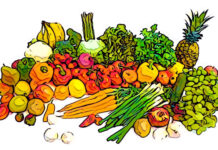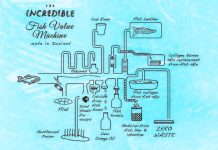The global food industry is increasingly focusing on sustainability, with a particular emphasis on reducing food loss and waste (FLW), also by upcycling by-products into valuable food ingredients. A recent study by Renzetti and van der Sman (2024) published in Food Hydrocolloids offers a groundbreaking perspective on this issue, demonstrating how fibre-rich by-products like wheat bran can be effectively incorporated into popular bakery products such as biscuits without compromising their texture or sensory properties.
The challenge of by-products upcycling in food formulation
By-products from food processing, such as wheat bran, are rich in dietary fibres, proteins, vitamins, and minerals, making them ideal candidates for enhancing the nutritional value of food products. However, their incorporation into popular foods like biscuits has traditionally been challenging due to their impact on dough rheology and the final product’s texture.
Wheat bran, a by-product of wheat milling, for instance, is known to increase dough elasticity and reduce biscuit spread, leading to harder and less palatable products (Renzetti & van der Sman, 2024). These challenges have limited the widespread use of such by-products in food formulation, despite their potential health benefits linked with the increase of fibers.
A holistic approach to reformulation
The study by Renzetti and van der Sman (2024) addresses these challenges by proposing a holistic approach to reformulation. The authors suggest that the negative effects of bran enrichment on dough rheology and biscuit properties can be mitigated by adjusting the properties of the water-sugar mixture through sugar replacement. Specifically, they focus on two key physicochemical parameters: the volumetric density of hydrogen bonds and the Flory-Huggins water interaction parameter. These parameters describe the plasticizing and hygroscopic properties of sugars, respectively, and can be manipulated to compensate for the alterations caused by bran enrichment.
The researchers conducted a series of experiments in which they varied the ratio of bran to flour and replaced sucrose with alternative sweeteners such as fructo-oligosaccharides and xylitol. They found that by reducing the plasticizing and hygroscopic properties of the sugar mixture, they could counteract the increase in dough elasticity induced by bran enrichment. This approach allowed them to produce bran-enriched biscuits with similar texture and spread properties to traditional biscuits, effectively decoupling the nutritional composition from the textural properties of the product.
Main outcomes and implications
The study’s results demonstrate that the identified parameters can accurately predict the physical properties of dough and biscuits. By adjusting these parameters, it is possible to create bran-enriched biscuits with desirable texture and nutritional benefits. For example, replacing sucrose with fructo-oligosaccharides, which have higher values, delayed the onset of gluten thermosetting during baking, resulting in biscuits with increased spread and reduced hardness. Conversely, using xylitol, which has lower values, enhanced the elastic behaviour of the dough, leading to harder biscuits with reduced spread.
These findings have significant implications for the food industry, as they provide a scientific basis for the reformulation of bakery products to include more sustainable and nutrient-dense ingredients. By leveraging the principles outlined in this study, manufacturers can create healthier products without compromising on taste or texture, thereby meeting consumer demand for both nutrition and indulgence.
Insights from the study’s first author
In a statement, Stefano Renzetti, the first author of the study and a researcher at Wageningen University, elaborated on the broader implications of their work:
‘In general, we are trying to valorise processing by-products such as cereal bran (rich in both proteins and fibres, as well as micronutrients like vitamins and minerals), legume processing residues (e.g., okara), which are also rich in fibres and proteins, and even fruit and vegetable pulp. The idea is that with a holistic approach to product formulation, we can achieve desired texture properties from different combinations of ingredients. For example, in the attached article, we demonstrated that enriching a biscuit with wheat bran alters its texture properties. However, if the addition of bran is done in conjunction with a substitution of added sugars (using soluble fibres instead of sugar), the negative effects can be compensated for, resulting in a product with a similar texture’.
Broader applications and future directions
The principles outlined in this study are not limited to biscuits or wheat bran. They can be applied to a wide range of food products and by-products, including legume residues, fruit pulp, and vegetable waste. For instance, okara, a by-product of soy milk production, is rich in protein and fibre and could be incorporated into baked goods using similar formulation strategies. Similarly, fruit and vegetable pulps, which are often discarded during juice production, could be upcycled into nutrient-dense ingredients for various food applications.
Future research could explore the application of these principles to other food matrices, such as cakes, bread, and snacks, as well as the use of different by-products. Additionally, sensory studies could be conducted to assess consumer acceptance of these reformulated products, ensuring that they meet both nutritional and sensory expectations.
Conclusion
The study by Renzetti and van der Sman (2024) represents a significant step forward in the upcycling of food by-products into innovative and sustainable ingredients, and improving circular economy performances.
By providing a scientific framework for the reformulation of bakery products, this research opens up new possibilities for the food industry to create healthier, more sustainable products without compromising on quality.
Further research ought to be promoted, to meet the socioeconomic need to reduce food loss and waste (FLW) in all agri-food sectors, including wine, and to add value to the respective by-products all over their supply chains, from farm to fork.
Dario Dongo
References
• Renzetti, S., & van der Sman, R. G. M. (2024). Combining bran-enrichment with sugar replacement in biscuits enables the flexible use of a sustainable and fibre-rich by-product. Food Hydrocolloids, 146, 109226. https://doi.org/10.1016/j.foodhyd.2023.109226
• A., Jurgens, A., & Van Vliet, T. (1997). Rheological properties of short doughs at small deformation. Journal of Cereal Science, 26, 289–300. https://doi.org/10.1006/jcrs.1997.0134
• Chevallier, S., Della Valle, G., Colonna, P., Broyart, B., & Trystram, G. (2002). Structural and chemical modifications of short dough during baking. Journal of Cereal Science, 35(1), 1–10. https://doi.org/10.1006/jcrs.2001.0388
• Day, L., Xu, M., Øiseth, S. K., Hemar, Y., & Lundin, L. (2010). Control of morphological and rheological properties of carrot cell wall particle dispersions through processing. Food and Bioprocess Technology, 3(6), 928–934. https://doi.org/10.1007/s11947-010-0346-0
• Handa, C., Goomer, S., & Siddhu, A. (2012). Physicochemical properties and sensory evaluation of fructoligosaccharide enriched cookies. Journal of Food Science and Technology, 49(2), 192–199. https://doi.org/10.1007/s13197-011-0277-4
• Renzetti, S., & van der Sman, R. G. M. (2022). Food texture design in sugar reduced cakes: Predicting batters rheology and physical properties of cakes from physicochemical principles. Food Hydrocolloids, 131, 1–11. https://doi.org/10.1016/j.foodhyd.2022.107795
• van der Sman, R. G. M., & Renzetti, S. (2019). Understanding functionality of sucrose in biscuits for reformulation purposes. Critical Reviews in Food Science and Nutrition, 59(14), 2225–2239. https://doi.org/10.1080/10408398.2018.1442315
• van der Sman, R. G. M., Jurgens, A., Smith, A., & Renzetti, S. (2022). Universal strategy for sugar replacement in foods? Food Hydrocolloids, 133, 107966. https://doi.org/10.1016/j.foodhyd.2022.107966
Dario Dongo, lawyer and journalist, PhD in international food law, founder of WIISE (FARE - GIFT - Food Times) and Égalité.








